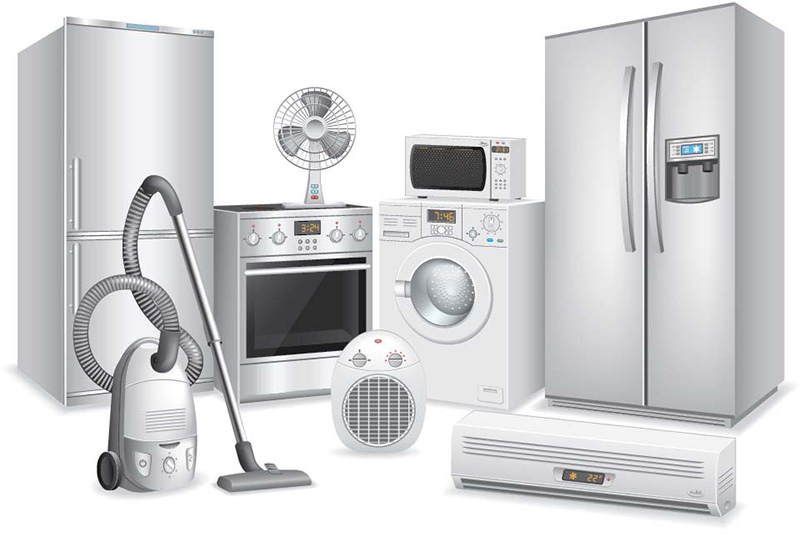Global efforts to reduce power consumption are only increasing, with many countries requiring that home appliances, like those shown in Figure 1, meet efficiency standards set by organizations such as the China Institute of Standards (CNIS), Energy Star in the United States and Blue Angel in Germany. To meet these standards, system designers are increasingly moving away from simple, easy-to-use, single-phase AC induction motor-based designs to those using more power-efficient, low-voltage brushless-DC (BLDC) motors. Designers of small home appliances like vacuum robots are also transitioning many of their systems to more advanced BLDC motors to achieve longer lifetimes and quieter operation. Simultaneously, advancements in permanent magnet technology are simplifying the manufacturing of BLDC motors, reducing system size while delivering the same torque (load), with the added benefits of higher efficiency and quieter systems.

Figure 1: Typical home appliances
Designing systems with BLDC motors can be challenging, because it usually requires complex hardware and optimized software designs to deliver reliable real-time control. One option to speed design cycles is to adopt BLDC motor modules from specialized vendors, but these modules aren’t optimized to meet specific system needs. So, building an optimized high-performance system to meet your specific application needs still requires a deep understanding of motor design and control – even when using a module. In this article, I will discuss three methods to speed BLDC motor system design, while still delivering an energy efficient, smarter and smaller solution.

Learn how to tune your motor faster
 |
Watch this video to see us tune a BLDC motor in less than 10 minutes using the MCF8316A BLDC motor driver with field-oriented control. |

Method No. 1: Code-free sensorless control
A code-free motor driver includes a built-in control commutation algorithm that can eliminate motor control software development, maintenance and qualification. These motor drivers typically take feedback from the motor, such as Hall signals or motor-phase voltage and current signals; compute complex control equations in real-time to determine the next motor driving state; and give out pulse-width modulation signals for analog front-end components such as the gate driver or metal-oxide semiconductor field-effect transistor (MOSFET) (see Figure 2).

Figure 2: A typical sensorless BLDC motor system
Using a motor driver for real-time control that integrates sensorless control, like our MCF8316A motor driver with field-oriented control (FOC), can increase system reliability and lower total system cost by eliminating the need for Hall-effect sensors in the motor. A code-free motor driver also manages critical functions, such as motor fault detection, and implements protection mechanisms to make the overall system design more reliable. These devices can come with pre-certified control algorithm implementations from certification bodies such as Underwriters Laboratories, enabling original equipment manufacturers to reduce design time for their home appliances.
Method No. 2: Easy motor tuning using intelligent motor control
Tuning a BLDC motor to meet system performance parameters such as speed, efficiency and acoustic noise can be difficult. It is possible to develop a sensorless trapezoidal control algorithm, where the motor’s back electromotive force voltage determines the commutation such that tuning is independent of the motor parameters. An integrated motor driver, such as the MCT8316A with integrated sensorless trapezoidal control, can deliver optimized system performance without requiring a complex interface to a microcontroller. Additionally, as a reference during the motor tuning process, integrated motor drivers provide feedback signals such as motor phase voltage, current and motor speed that are visible on an oscilloscope.
In a sensorless FOC algorithm, the integration of advanced control techniques can significantly speed motor tuning, for example, by self-measuring motor parameters or automating control-loop tuning. A guided tuning graphical user interface (GUI) that provides default options for motor start-up, like the one shown in Figure 3, can assist you with the tuning process and quickly get your motor spinning. Code-free motor drivers such as the MCF8316A for FOC and MCT8316A for trapezoidal control include multiple configurable options for motor start-up, as well as closed-loop and motor-stop operations. This enables you to optimize motor performance in matter of minutes – significantly reducing design cycle time.

Figure 3: Guided tuning GUI
Method No. 3: Make it smaller
Building hardware for a BLDC system can be overwhelming for many system designers. A typical system requires gate drivers, MOSFETs, current-sense amplifiers, voltage sensing comparators and analog-to-digital converters. Most systems require a dedicated power architecture, including devices such low-dropout regulators or DC/DC step-down regulators to power all of the components on the board. An integrated BLDC driver combines all of these components and delivers a compact, yet easy-to-use solution, as shown in Figure 4.

Figure 4: A fully integrated BLDC motor solution
Motor drivers with integrated control include protection features such as over-current and over-voltage protection for MOSFETs as well as temperature monitoring, making it easy for designers to deliver powerful solutions. For motor applications that use less than 70 W, such as vacuum robots, residential ceiling fans or pumps used in washing machines, you can choose devices with integrated MOSFETs to further reduce board space. The MCF8316A and MCT8316A devices support up to 8-A peak current for 24-V applications. For high-power applications, you can place power MOSFETs on the board with the gate driver and motor control integrated into one chip.
The concepts discussed in this article can help accelerate system design cycles while also delivering smaller and smarter BLDC motor systems. Code-free, integrated sensorless control BLDC motor drivers such as the MCF8316A and MCT8316A can help you quickly design optimized, high-performing real-time control systems. These devices can deliver as much as 70 W of power for 24-V applications. With integrated intelligent control techniques, both motor drivers are easy to tune, enable high-performance and reliable system solutions, and are great options to consider as you look to build your next low-voltage, energy-efficient BLDC-based system.








